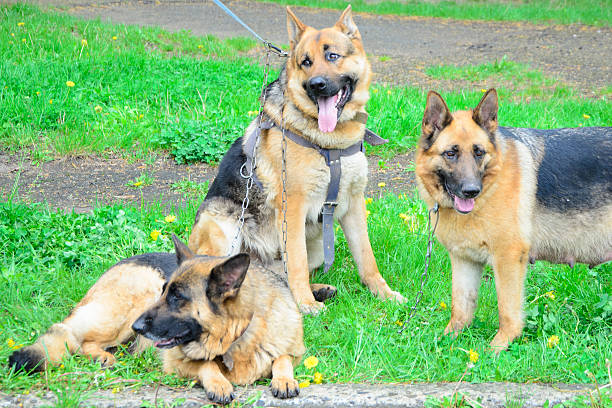German Shepherds are one of the most famous dog breeds, admired for their wisdom, loyalty, and flexibility. However, many owners fight to realize the types of German Shepherd coats and how they affect grooming, shedding, and overall care. Whether you’re choosing a puppy or learning how to manage your dog’s coat, knowing the varieties is important.
German Shepherds can have short, medium, or long coats, and some are double-coated, while others are single-coated. The types of German Shepherd coats not only impact show but also determine how much they shed, their propriety for different temperatures, and their grooming needs. Without proper knowledge, many owners face challenges in coat maintenance, leading to extreme shedding, matting, or discomfort for their dogs.
By understanding the different types of German Shepherd coats, you can choose the right grooming routine, control shedding effectively, and ensure your dog stays healthy and comfortable. In the following sections, we’ll explore each coat type in detail, their characteristics, and the best care tips for each.
German Shepherds have three main coat types
- Short Coat (Stock Coat) – Dense, short double coat; moderate grooming; suited for warm to moderate climates.
- Medium Coat (Plush Coat) – Slightly longer and thicker; better cold opposition; requires more brushing.
- Long Coat (Long Stock Coat) – Long, silky fur; some have an undercoat; needs frequent grooming; ideal for colder climates.
German Shepherds can be double-coated or single-coated
Double-Coated German Shepherds
A double-covered German Shepherd has layers of fur: a gentle, dense undercoat that gives insulation and a coarse outer coat that protects from dirt, water, and vicious weather. This coat type is commonplace in the breed and facilitates their adaptation to both warm and bloodless temperatures. Among the unique types of German Shepherd coats, the double coat requires the most maintenance due to heavy shedding, particularly during seasonal changes. Regular brushing is crucial to control loose fur and prevent matting.
Single-Coated German Shepherds
An unmarried, uncovered German shepherd lacks the thick undercoat and has the best outer protective hairs. do not have the same level of protection against harsh weather conditions; now they have the same stage of protection in opposition to intense weather. In comparison to other types of German Shepherd coats, the undercoat gives much less insulation, making those dogs more sensitive to bloodless temperatures. Single-coated German Shepherds are rarer and can require greater care in less warm climates to keep them warm.
The Structure of a German Shepherd’s Coat
German Shepherds possess a double-layered coat designed to protect them from various environmental factors:
- Undercoat: This dense, woolly layer provides insulation, keeping the dog warm in cold climates and cool in warmer temperatures.
- Outer Coat (Guard Hairs): These are longer, coarser hairs that repel dirt and moisture, safeguarding the skin underneath.
Variations in Coat Length
One can categorize the length of a German Shepherd’s coat into four distinct types:
Short Coat with Undercoat
The most unusual type functions quickly, directly on hair that lies close to the body. This coat is practical for working dogs due to its low maintenance and powerful protection.
Medium Coat with Undercoat (Plush Coat)
The coat is slightly longer than the short coat, giving it a fuller appearance. Although it’s not as long as the long coat, it still exudes a luxurious look, hence the name.
Long Coat with Undercoat
This breed showcases long, flowing hair with a thick undercoat. The fur is particularly prominent around the neck, tail, and legs, giving the canine a majestic look.
Long Coat without Undercoat
The coat is characterized by its long, tender hair but lacks a dense undercoat. This trait makes the coat much less protective in harsh weather conditions.
Plush Coat German Shepherd
A plush coat The German Shepherd has a coat length among the short and long-haired varieties. Their fur is thicker and fuller and comes with a dense undercoat, giving them a fluffy appearance. While they require slight grooming, they shed closely. Learn powerful methods to manipulate droppings in German shepherds.
Standard German Shepherd Colors
| Color | Description | Recognition | Rarity |
| Black & Tan | The most common color; is black saddle and tan legs, chest, and face. | AKC & FCI Recognized | Common |
| Black & Red | Similar to black & tan but with a deeper, reddish hue. | AKC & FCI Recognized | Common |
| Black & Cream | A lighter version of black & tan; cream replaces tan. | AKC Recognized | Less Common |
| Black & Silver | Black saddle with silver markings on legs and face. | AKC Recognized | Less Common |
| Sable | Each hair strand has multiple colors, ranging from light tan to dark black. | AKC & FCI Recognized | Common |
| Solid Black | Entirely black coat with no markings. | AKC Recognized | Rare |
| Bi-Color | Mostly black with minimal tan or red markings, usually on the legs and face. | AKC Recognized | Rare |
Coat Colors and Patterns
German Shepherds exhibit a wide array of coat colors and patterns, influenced by genetics:
- Black and Tan: The most recognized combination, with a black saddle-like pattern on the back and tan on the legs, chest, and face.
- Sable: Each hair has multiple bands of color, typically black-tipped over a lighter base, giving a dynamic, wolf-like appearance.
- Solid Black: Entirely black fur, presenting a sleek and striking look.
- White: A pure white coat, which, while beautiful, is not recognized by some breed standards for show purposes.
- Blue and Liver: These rare colors result from recessive genes, leading to diluted pigmentation.
- Panda: A unique pattern featuring a mix of black and white patches, resembling a panda bear.
- Bi-Color: Predominantly black with minimal tan markings, often on the legs and face.
- Solid White: White German Shepherds have a pure white coat. It’s important to note that while certain organizations recognize them, they may be disqualified from conformation shows under some breed standards.
The Role of Genetics in Coat Variations

Genetics primarily influences the variety of German Shepherd coat types. Coat duration is determined by a recessive gene; that means each parent needs to bring it for a puppy to have a protracted coat. Different genes control pigmentation, patterning, and styling. The sable gene is dominant, making it more common, while stable black or white coats result from specific recessive genes. Understanding those genetic factors enables breeders to expect coat variations and hold breed standards.
Grooming and Care for Different Coat Types
Proper grooming is essential to maintain the health and appearance of a German Shepherd’s coat:
- Short Coat: Requires regular brushing, at least once a week, to remove loose hairs and distribute natural oils.
- Medium and Long Coats: Need more frequent brushing, ideally several times a week, to prevent matting and tangling. Special attention should be given to areas prone to knots, such as behind the ears and under the legs.
- Bathing: Regardless of coat type, bathing should be done every 4-6 weeks or as needed, using dog-specific shampoos to maintain skin health.
- Seasonal Shedding: German Shepherds experience increased shedding during spring and fall. During these periods, daily brushing can help manage the excess fur.
Impact of Diet on Coat Health

The types of German shepherd coats play a substantial role in determining the rate of a puppy or grown-up canine. These coat types are the most common and typically fall within a standard price range, often belonging to a well-known breed. However, due to their rarity and distinctive appearance, German Shepherds with lengthy coats tend to command higher prices. Additionally, plush coats in German Shepherds might also command a higher fee, as they are less common and renowned for their placing and fuller fur.
Beyond aesthetics, the renovation and grooming needs of various types of German shepherd coats additionally affect pricing. Dogs with long or plush coats require greater grooming and care, making them more suitable for the ones willing to put money into preservation. Breeders may also charge more for puppies with specific coat colorings or styles due to their rarity. Understanding the impact of German Shepherd coats on pricing helps capability owners make knowledgeable decisions when selecting an associate who suits their finances and lifestyle.
Coat Types and Their Influence on Pricing
The types of German Shepherd coats significantly impact pricing.
Standard Coat Pricing
Short inventory coats are the most commonplace and usually extra low-cost because they align with breed standards and are widely available.
Premium and Rare Coat Pricing
Long-coated German Shepherds or those with rare colors, like strong black, regularly cost extra due to their area of expertise and higher demand.
Show-Quality Pricing
Show-first-class German Shepherds with well-described coat patterns and textures generally have a higher price tag.
Other Pricing Factors
Factors like genetics, breeder recognition, and coat health similarly have an impact on fees, making the coat type a crucial consideration while buying a German Shepherd.
Final Thoughts
Understanding the various types of German shepherd coats is essential for prospective and contemporary owners. Each coat type, whether brief, medium, or lengthy, with or without an undercoat, offers precise issues in terms of grooming, shedding, and care. Recognizing these differences guarantees that you could provide the best viable care tailor-made to your German Shepherd’s unique needs, promoting their health and well-being.
FAQs
Do long-coated German Shepherds require more grooming than quick-lined ones?
German Shepherds need extra frequent brushing to save you from tangles and mats.
Are certain coat hues linked to health troubles?
Certain uncommon colors, such as blue or liver, may indicate genetic health concerns. Always discuss with a reputable breeder.
Can I shave my German Shepherds during the summer to keep them cool?
We do not endorse it. Their double coat regulates frame temperature, and shaving can disrupt this stability.
What are the one-of-a-kind coat varieties determined in German Shepherds?
German Shepherds typically have four coat types: quick with an undercoat, medium (plush) with an undercoat, lengthy with an undercoat, and lengthy without an undercoat.
How does the coat type affect a German Shepherd’s grooming needs?
Short-haired German Shepherds require regular brushing to manage loss, while long-haired sorts need greater frequent grooming to prevent matting and tangling.
Conclusion
The rich diversity in types of German Shepherd coats adds to the breed’s allure and functionality. Understanding these variations enables owners and enthusiasts to provide appropriate care, appreciate the breed’s aesthetics, and make informed decisions when selecting a companion. Whether a German Shepherd has a short, long, or plush coat, knowing the specific needs of different types of German Shepherd coats helps ensure proper grooming, nutrition, and overall well-being.

